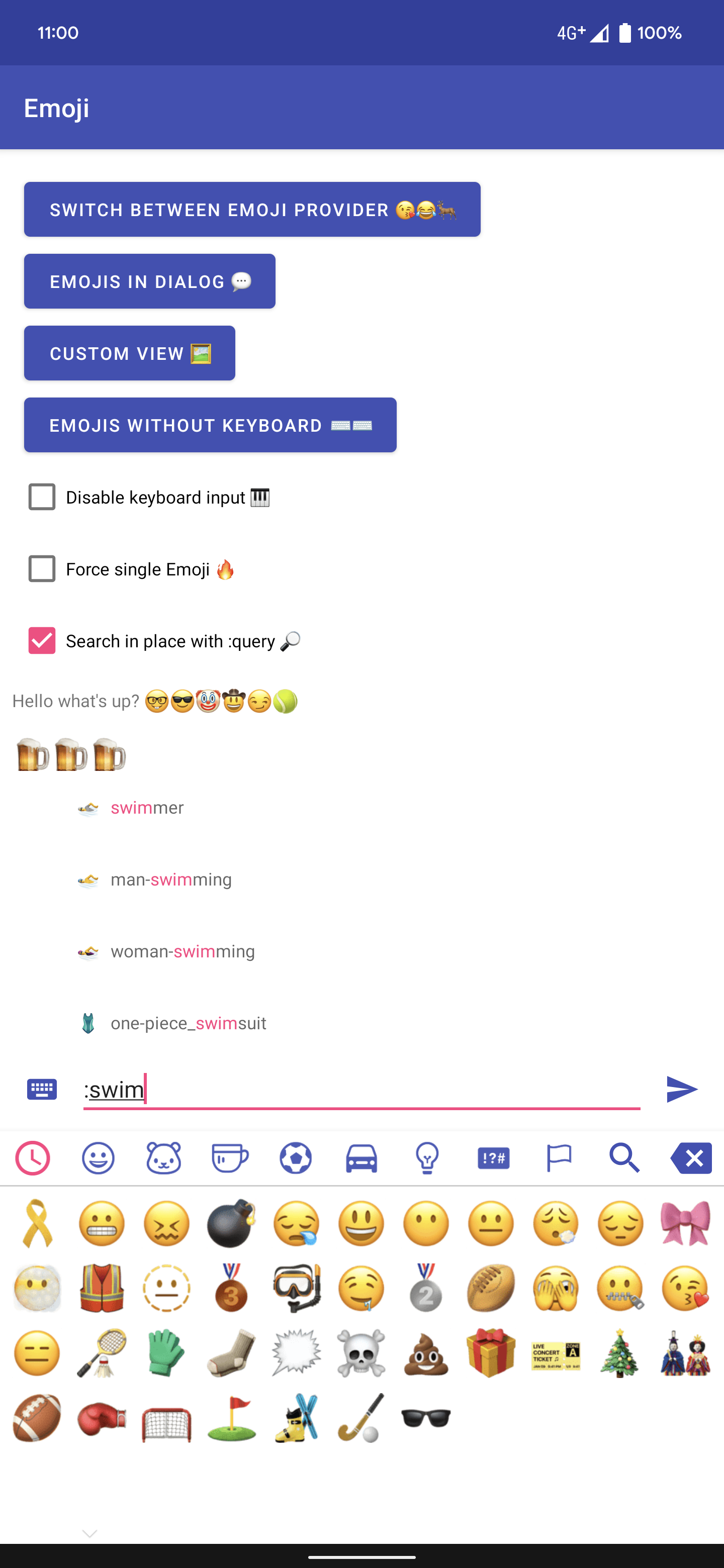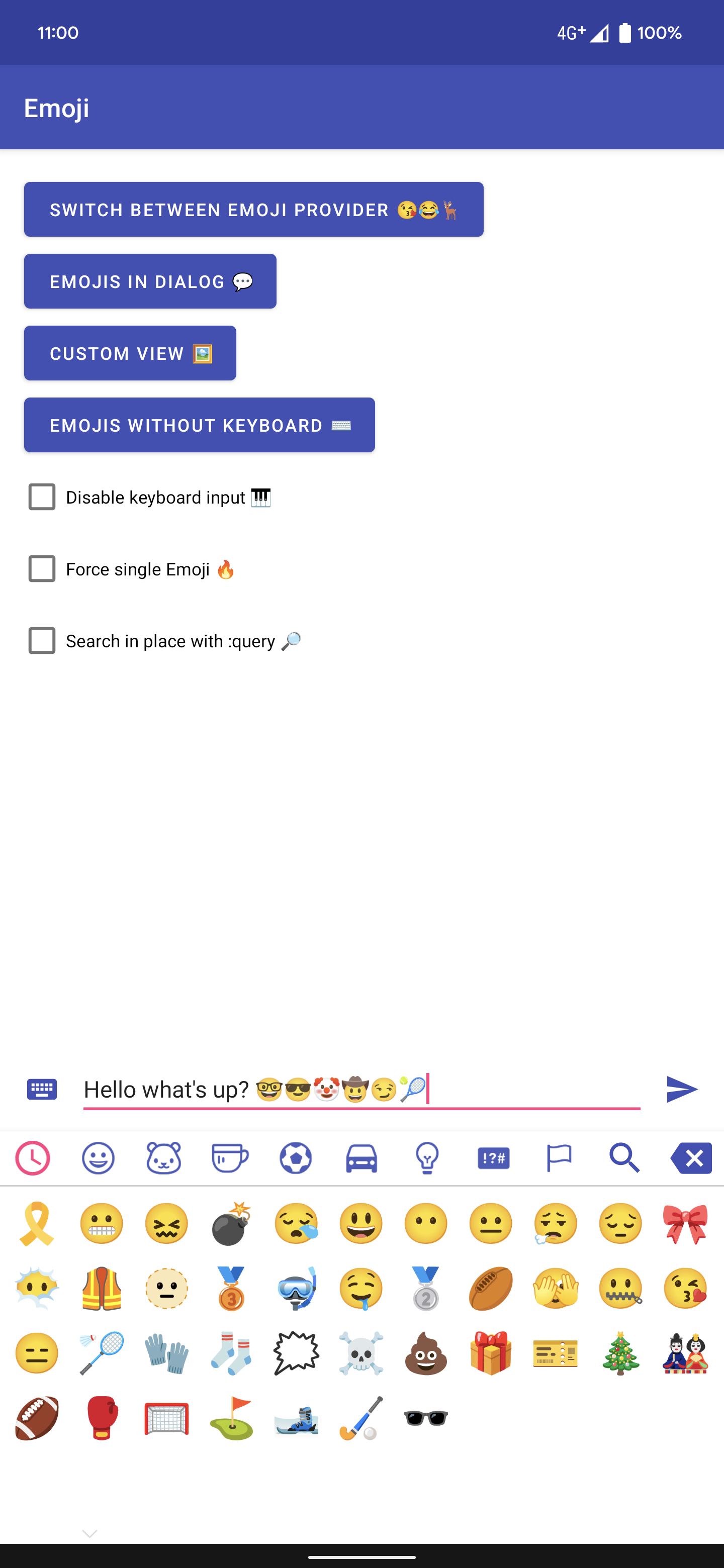A Kotlin Multiplatform library to add Emoji support to your Android App / JVM Backend.
- JVM
- Check out the sample jvm module for text parsing / searching functionality
- Android
- Picking
EmojiPopup- PopupWindow which overalys over the soft keyboardEmojiView- Normal view which is used byEmojiPopupand can also be used as a standalone to select emojis via categories
- Displaying (Android)
EmojiAutoCompleteTextViewEmojiButtonEmojiCheckboxEmojiEditTextEmojiMultiAutoCompleteTextViewEmojiTextView- For convenience, there's also a
EmojiLayoutFactory, which can be used to get automatic Emoji support when using normal Android Views such asTextView,Checkbox, etc.
- Picking
The library has 4 different sprites providers to choose from (iOS, Google, Facebook & Twitter). The emoji's are packaged as pictures and loaded at runtime. If you want to use a Font provider, check out Google Compat.
For getting the above iOS Emojis, add the dependency:
implementation "com.vanniktech:emoji-ios:0.18.0-SNAPSHOT"And install the provider in your Application class.
import com.vanniktech.emoji.EmojiManager
import com.vanniktech.emoji.ios.IosEmojiProvider
EmojiManager.install(IosEmojiProvider())For getting the above Google Emojis, add the dependency:
implementation "com.vanniktech:emoji-google:0.18.0-SNAPSHOT"And install the provider in your Application class.
import com.vanniktech.emoji.EmojiManager
import com.vanniktech.emoji.google.GoogleEmojiProvider
EmojiManager.install(GoogleEmojiProvider())For getting the above Facebook Emojis, add the dependency:
implementation "com.vanniktech:emoji-facebook:0.18.0-SNAPSHOT"And install the provider in your Application class.
import com.vanniktech.emoji.EmojiManager
import com.vanniktech.emoji.facebook.FacebookEmojiProvider
EmojiManager.install(FacebookEmojiProvider())For getting the above Twitter Emojis, add the dependency:
implementation "com.vanniktech:emoji-twitter:0.18.0-SNAPSHOT"And install the provider in your Application class.
import com.vanniktech.emoji.EmojiManager
import com.vanniktech.emoji.twitter.TwitterEmojiProvider
EmojiManager.install(TwitterEmojiProvider())For getting the above Google Emojis, add the dependency (only works for Android Apps):
implementation "com.vanniktech:emoji-google-compat:0.18.0-SNAPSHOT"And install the provider in your Application class.
import androidx.core.provider.FontRequest
import androidx.emoji.text.EmojiCompat
import androidx.emoji.text.FontRequestEmojiCompatConfig
import com.vanniktech.emoji.EmojiManager
import com.vanniktech.emoji.googlecompat.GoogleCompatEmojiProvider
EmojiManager.install(GoogleCompatEmojiProvider(EmojiCompat.init(
FontRequestEmojiCompatConfig(
this,
FontRequest(
"com.google.android.gms.fonts",
"com.google.android.gms",
"Noto Color Emoji Compat",
R.array.com_google_android_gms_fonts_certs,
)
).setReplaceAll(true)
)
))Instead of using pictures, the Emojis are loaded via a Font which is downloaded at runtime, hence the library size is much much smaller in comparison. To load the font, please declare the following array:
<array name="com_google_android_gms_fonts_certs">
<item>@array/com_google_android_gms_fonts_certs_dev</item>
<item>@array/com_google_android_gms_fonts_certs_prod</item>
</array>
<string-array name="com_google_android_gms_fonts_certs_dev" tools:ignore="Typos">
<item>MIIEqDCCA5CgAwIBAgIJANWFuGx90071MA0GCSqGSIb3DQEBBAUAMIGUMQswCQYDVQQGEwJVUzETMBEGA1UECBMKQ2FsaWZvcm5pYTEWMBQGA1UEBxMNTW91bnRhaW4gVmlldzEQMA4GA1UEChMHQW5kcm9pZDEQMA4GA1UECxMHQW5kcm9pZDEQMA4GA1UEAxMHQW5kcm9pZDEiMCAGCSqGSIb3DQEJARYTYW5kcm9pZEBhbmRyb2lkLmNvbTAeFw0wODA0MTUyMzM2NTZaFw0zNTA5MDEyMzM2NTZaMIGUMQswCQYDVQQGEwJVUzETMBEGA1UECBMKQ2FsaWZvcm5pYTEWMBQGA1UEBxMNTW91bnRhaW4gVmlldzEQMA4GA1UEChMHQW5kcm9pZDEQMA4GA1UECxMHQW5kcm9pZDEQMA4GA1UEAxMHQW5kcm9pZDEiMCAGCSqGSIb3DQEJARYTYW5kcm9pZEBhbmRyb2lkLmNvbTCCASAwDQYJKoZIhvcNAQEBBQADggENADCCAQgCggEBANbOLggKv+IxTdGNs8/TGFy0PTP6DHThvbbR24kT9ixcOd9W+EaBPWW+wPPKQmsHxajtWjmQwWfna8mZuSeJS48LIgAZlKkpFeVyxW0qMBujb8X8ETrWy550NaFtI6t9+u7hZeTfHwqNvacKhp1RbE6dBRGWynwMVX8XW8N1+UjFaq6GCJukT4qmpN2afb8sCjUigq0GuMwYXrFVee74bQgLHWGJwPmvmLHC69EH6kWr22ijx4OKXlSIx2xT1AsSHee70w5iDBiK4aph27yH3TxkXy9V89TDdexAcKk/cVHYNnDBapcavl7y0RiQ4biu8ymM8Ga/nmzhRKya6G0cGw8CAQOjgfwwgfkwHQYDVR0OBBYEFI0cxb6VTEM8YYY6FbBMvAPyT+CyMIHJBgNVHSMEgcEwgb6AFI0cxb6VTEM8YYY6FbBMvAPyT+CyoYGapIGXMIGUMQswCQYDVQQGEwJVUzETMBEGA1UECBMKQ2FsaWZvcm5pYTEWMBQGA1UEBxMNTW91bnRhaW4gVmlldzEQMA4GA1UEChMHQW5kcm9pZDEQMA4GA1UECxMHQW5kcm9pZDEQMA4GA1UEAxMHQW5kcm9pZDEiMCAGCSqGSIb3DQEJARYTYW5kcm9pZEBhbmRyb2lkLmNvbYIJANWFuGx90071MAwGA1UdEwQFMAMBAf8wDQYJKoZIhvcNAQEEBQADggEBABnTDPEF+3iSP0wNfdIjIz1AlnrPzgAIHVvXxunW7SBrDhEglQZBbKJEk5kT0mtKoOD1JMrSu1xuTKEBahWRbqHsXclaXjoBADb0kkjVEJu/Lh5hgYZnOjvlba8Ld7HCKePCVePoTJBdI4fvugnL8TsgK05aIskyY0hKI9L8KfqfGTl1lzOv2KoWD0KWwtAWPoGChZxmQ+nBli+gwYMzM1vAkP+aayLe0a1EQimlOalO762r0GXO0ks+UeXde2Z4e+8S/pf7pITEI/tP+MxJTALw9QUWEv9lKTk+jkbqxbsh8nfBUapfKqYn0eidpwq2AzVp3juYl7//fKnaPhJD9gs=</item>
</string-array>
<string-array name="com_google_android_gms_fonts_certs_prod" tools:ignore="Typos">
<item>MIIEQzCCAyugAwIBAgIJAMLgh0ZkSjCNMA0GCSqGSIb3DQEBBAUAMHQxCzAJBgNVBAYTAlVTMRMwEQYDVQQIEwpDYWxpZm9ybmlhMRYwFAYDVQQHEw1Nb3VudGFpbiBWaWV3MRQwEgYDVQQKEwtHb29nbGUgSW5jLjEQMA4GA1UECxMHQW5kcm9pZDEQMA4GA1UEAxMHQW5kcm9pZDAeFw0wODA4MjEyMzEzMzRaFw0zNjAxMDcyMzEzMzRaMHQxCzAJBgNVBAYTAlVTMRMwEQYDVQQIEwpDYWxpZm9ybmlhMRYwFAYDVQQHEw1Nb3VudGFpbiBWaWV3MRQwEgYDVQQKEwtHb29nbGUgSW5jLjEQMA4GA1UECxMHQW5kcm9pZDEQMA4GA1UEAxMHQW5kcm9pZDCCASAwDQYJKoZIhvcNAQEBBQADggENADCCAQgCggEBAKtWLgDYO6IIrgqWbxJOKdoR8qtW0I9Y4sypEwPpt1TTcvZApxsdyxMJZ2JORland2qSGT2y5b+3JKkedxiLDmpHpDsz2WCbdxgxRczfey5YZnTJ4VZbH0xqWVW/8lGmPav5xVwnIiJS6HXk+BVKZF+JcWjAsb/GEuq/eFdpuzSqeYTcfi6idkyugwfYwXFU1+5fZKUaRKYCwkkFQVfcAs1fXA5V+++FGfvjJ/CxURaSxaBvGdGDhfXE28LWuT9ozCl5xw4Yq5OGazvV24mZVSoOO0yZ31j7kYvtwYK6NeADwbSxDdJEqO4k//0zOHKrUiGYXtqw/A0LFFtqoZKFjnkCAQOjgdkwgdYwHQYDVR0OBBYEFMd9jMIhF1Ylmn/Tgt9r45jk14alMIGmBgNVHSMEgZ4wgZuAFMd9jMIhF1Ylmn/Tgt9r45jk14aloXikdjB0MQswCQYDVQQGEwJVUzETMBEGA1UECBMKQ2FsaWZvcm5pYTEWMBQGA1UEBxMNTW91bnRhaW4gVmlldzEUMBIGA1UEChMLR29vZ2xlIEluYy4xEDAOBgNVBAsTB0FuZHJvaWQxEDAOBgNVBAMTB0FuZHJvaWSCCQDC4IdGZEowjTAMBgNVHRMEBTADAQH/MA0GCSqGSIb3DQEBBAUAA4IBAQBt0lLO74UwLDYKqs6Tm8/yzKkEu116FmH4rkaymUIE0P9KaMftGlMexFlaYjzmB2OxZyl6euNXEsQH8gjwyxCUKRJNexBiGcCEyj6z+a1fuHHvkiaai+KL8W1EyNmgjmyy8AW7P+LLlkR+ho5zEHatRbM/YAnqGcFh5iZBqpknHf1SKMXFh4dd239FJ1jWYfbMDMy3NS5CTMQ2XFI1MvcyUTdZPErjQfTbQe3aDQsQcafEQPD+nqActifKZ0Np0IS9L9kR/wbNvyz6ENwPiTrjV2KRkEjH78ZMcUQXg0L3BYHJ3lc69Vs5Ddf9uUGGMYldX3WfMBEmh/9iFBDAaTCK</item>
</string-array>If you want to display your own Emojis you can create your own implementation of EmojiProvider and pass it to EmojiManager.install.
All of the core API lays in emoji, which is being pulled in automatically by the providers:
implementation "com.vanniktech:emoji:0.18.0-SNAPSHOT"Material Design Library bindings can be included via:
implementation "com.vanniktech:emoji-material:0.18.0-SNAPSHOT"For convenience, there's also a MaterialEmojiLayoutFactory, which can be used to get automatic Emoji support.
Declare your EmojiEditText in your layout xml file.
<com.vanniktech.emoji.EmojiEditText
android:id="@+id/emojiEditText"
android:layout_width="match_parent"
android:layout_height="wrap_content"
android:imeOptions="actionSend"
android:inputType="textCapSentences|textMultiLine"
android:maxLines="3"/>To open the EmojiPopup execute the code below:
val emojiPopup = EmojiPopup(rootView, emojiEditText)
emojiPopup.toggle() // Toggles visibility of the Popup.
emojiPopup.dismiss() // Dismisses the Popup.
emojiPopup.isShowing() // Returns true when Popup is showing.The rootView is the rootView of your layout xml file which will be used for calculating the height of the keyboard.
emojiEditText is the EmojiEditText that you declared in your layout xml file.
<com.vanniktech.emoji.EmojiTextView
android:id="@+id/emojiTextView"
android:layout_width="wrap_content"
android:layout_height="wrap_content"/>Just use the EmojiTextView and call setText with the String that contains Unicode encoded Emojis. To change the size of the displayed Emojis call one of the setEmojiSize methods.
The EmojiPopup class allows you to declare several listeners.
EmojiPopup(
onSoftKeyboardCloseListener = { },
onEmojiClickListener = { },
onSoftKeyboardOpenListener = { },
onEmojiPopupShownListener = { },
onEmojiPopupDismissListener = { },
onEmojiBackspaceClickListener = { },
)You can pass your own implementation of the recent Emojis. Implement the RecentEmoji interface and pass it when you're building the EmojiPopup:
EmojiPopup(
recentEmoji = yourClassThatImplementsRecentEmoji,
)If no instance or a null instance is set the default implementation will be used.
You can pass your own implementation of the variant Emojis. Implement the VariantEmoji interface and pass it when you're building the EmojiPopup:
EmojiPopup(
variantEmoji = yourClassThatImplementsVariantEmoji,
)If no instance or a null instance is set the default implementation will be used.
You can pass your own implementation for searching Emojis. Implement the SearchEmoji interface and pass it when you're building the EmojiPopup:
EmojiPopup(
searchEmoji = yourClassThatImplementsSearchEmoji,
)If no instance or a null instance is set the default implementation will be used.
You can pass your own animation style for enter and exit transitions of the Emoji keyboard while you're building the EmojiPopup:
EmojiPopup(
keyboardAnimationStyle = emoji_fade_animation_style,
)If no style is set the keyboard will appear and exit as a regular PopupWindow. This library currently ships with two animation styles as an example:
- R.style.emoji_slide_animation_style
- R.style.emoji_fade_animation_style
You can pass your own Page Transformer for the Emoji keyboard View Pager while you're building the EmojiPopup:
EmojiPopup(
pageTransformer = MagicTransformer(),
)If no transformer is set ViewPager will behave as its usual self. Please do note that this library currently does not ship any example Page Transformers.
MaximalNumberOfEmojisInputFiltercan be used to limit the number of Emojis one can type into an EditTextOnlyEmojisInputFiltercan be used to limit the input of an EditText to emoji onlyForceSingleEmojiTraitcan be used to force a single emoji which can be replaced by a new oneDisableKeyboardInputTraitdisable input of the normal soft keyboardSearchInPlaceTraitsearch for an emoji using :queryEmojiViewView of all emojis and categories which does not depend on a keyboardEmojiEditText#disableKeyboardInput()to disable normal keyboard input. To undo call#enableKeyboardInput()
Most of them are also showcased in the sample app.
Install one of the providers you want, for instance the iOS Provider:
import com.vanniktech.emoji.EmojiManager
import com.vanniktech.emoji.ios.IosEmojiProvider
EmojiManager.install(IosEmojiProvider())Now you can use all the API's you want, for instance when you want to search for swim emojis, you can do:
import com.vanniktech.emoji.search.SearchEmojiManager
SearchEmojiManager().search(query = "swim")
.forEach {
println(it)
}This library is also distributed as a SNAPSHOT, if you like to check out the latest features: Add this to your repositories:
maven { url "https://oss.sonatype.org/content/repositories/snapshots" }implementation "com.vanniktech:emoji:0.18.0-SNAPSHOT"
implementation "com.vanniktech:emoji-ios:0.18.0-SNAPSHOT"
implementation "com.vanniktech:emoji-google:0.18.0-SNAPSHOT"
implementation "com.vanniktech:emoji-google-compat:0.18.0-SNAPSHOT"
implementation "com.vanniktech:emoji-twitter:0.18.0-SNAPSHOT"
implementation "com.vanniktech:emoji-facebook:0.18.0-SNAPSHOT"
implementation "com.vanniktech:emoji-material:0.18.0-SNAPSHOT"No configuration needed.
Copyright (C) 2016 - Niklas Baudy, Ruben Gees, Mario Đanić and contributors
Licensed under the Apache License, Version 2.0











